sensor FORD GT 2017 2.G Owners Manual
[x] Cancel search | Manufacturer: FORD, Model Year: 2017, Model line: GT, Model: FORD GT 2017 2.GPages: 313, PDF Size: 6.41 MB
Page 4 of 313
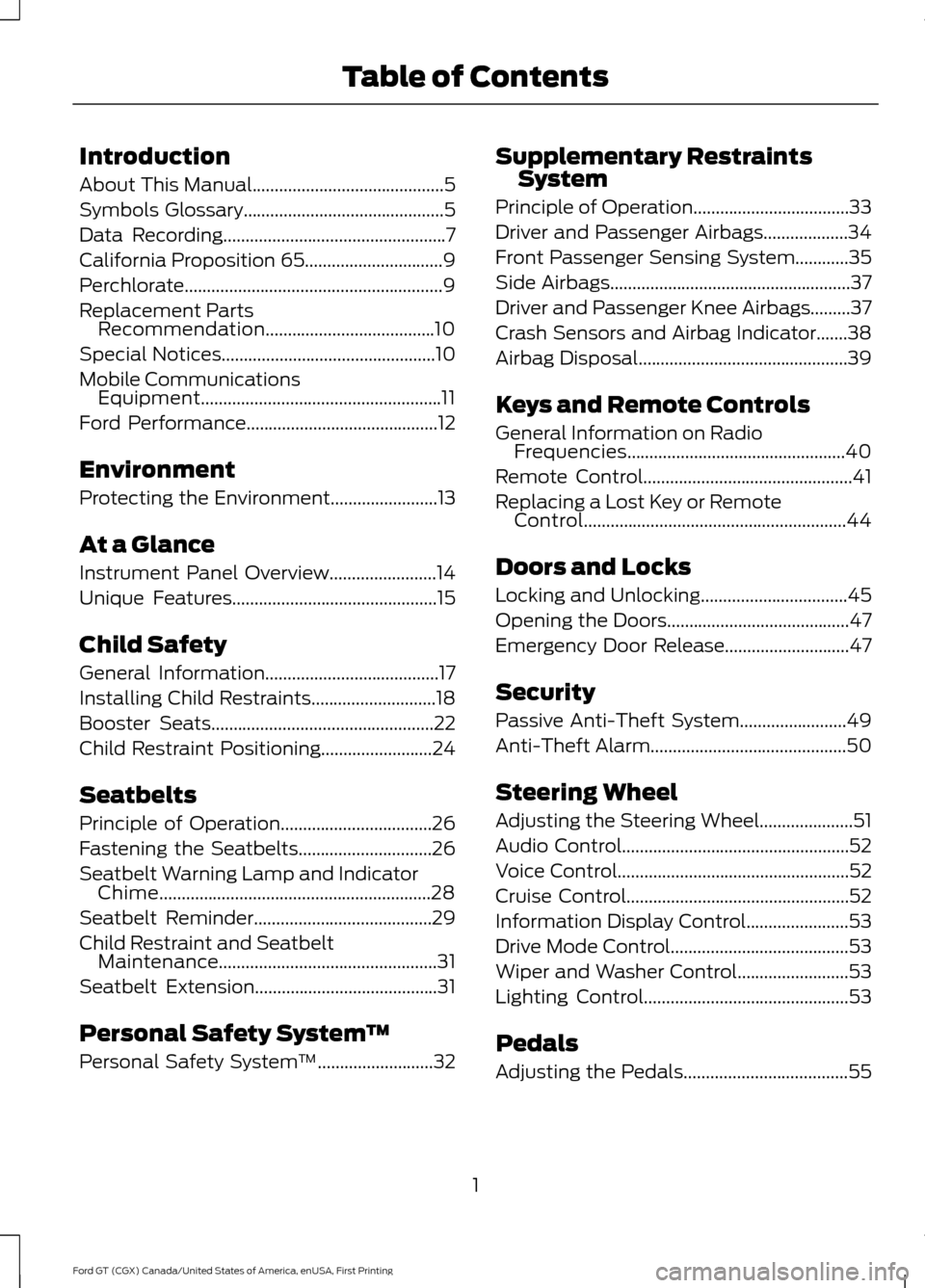
Introduction
About This Manual...........................................5
Symbols Glossary.............................................5
Data Recording..................................................7
California Proposition 65...............................9
Perchlorate..........................................................9
Replacement Parts Recommendation......................................10
Special Notices
................................................10
Mobile Communications Equipment......................................................11
Ford Performance...........................................12
Environment
Protecting the Environment
........................13
At a Glance
Instrument Panel Overview
........................14
Unique Features
..............................................15
Child Safety
General Information.......................................17
Installing Child Restraints
............................18
Booster Seats
..................................................22
Child Restraint Positioning.........................24
Seatbelts
Principle of Operation..................................26
Fastening the Seatbelts..............................26
Seatbelt Warning Lamp and Indicator Chime.............................................................28
Seatbelt Reminder
........................................29
Child Restraint and Seatbelt Maintenance
.................................................31
Seatbelt Extension.........................................31
Personal Safety System ™
Personal Safety System ™
..........................32Supplementary Restraints
System
Principle of Operation...................................33
Driver and Passenger Airbags...................34
Front Passenger Sensing System............35
Side Airbags......................................................37
Driver and Passenger Knee Airbags.........37
Crash Sensors and Airbag Indicator.......38
Airbag Disposal...............................................39
Keys and Remote Controls
General Information on Radio Frequencies.................................................40
Remote Control...............................................41
Replacing a Lost Key or Remote Control...........................................................44
Doors and Locks
Locking and Unlocking
.................................45
Opening the Doors.........................................47
Emergency Door Release............................47
Security
Passive Anti-Theft System........................49
Anti-Theft Alarm............................................50
Steering Wheel
Adjusting the Steering Wheel.....................51
Audio Control...................................................52
Voice Control
....................................................52
Cruise Control..................................................52
Information Display Control.......................53
Drive Mode Control........................................53
Wiper and Washer Control.........................53
Lighting Control
..............................................53
Pedals
Adjusting the Pedals
.....................................55
1
Ford GT (CGX) Canada/United States of America, enUSA, First Printing Table of Contents
Page 12 of 313
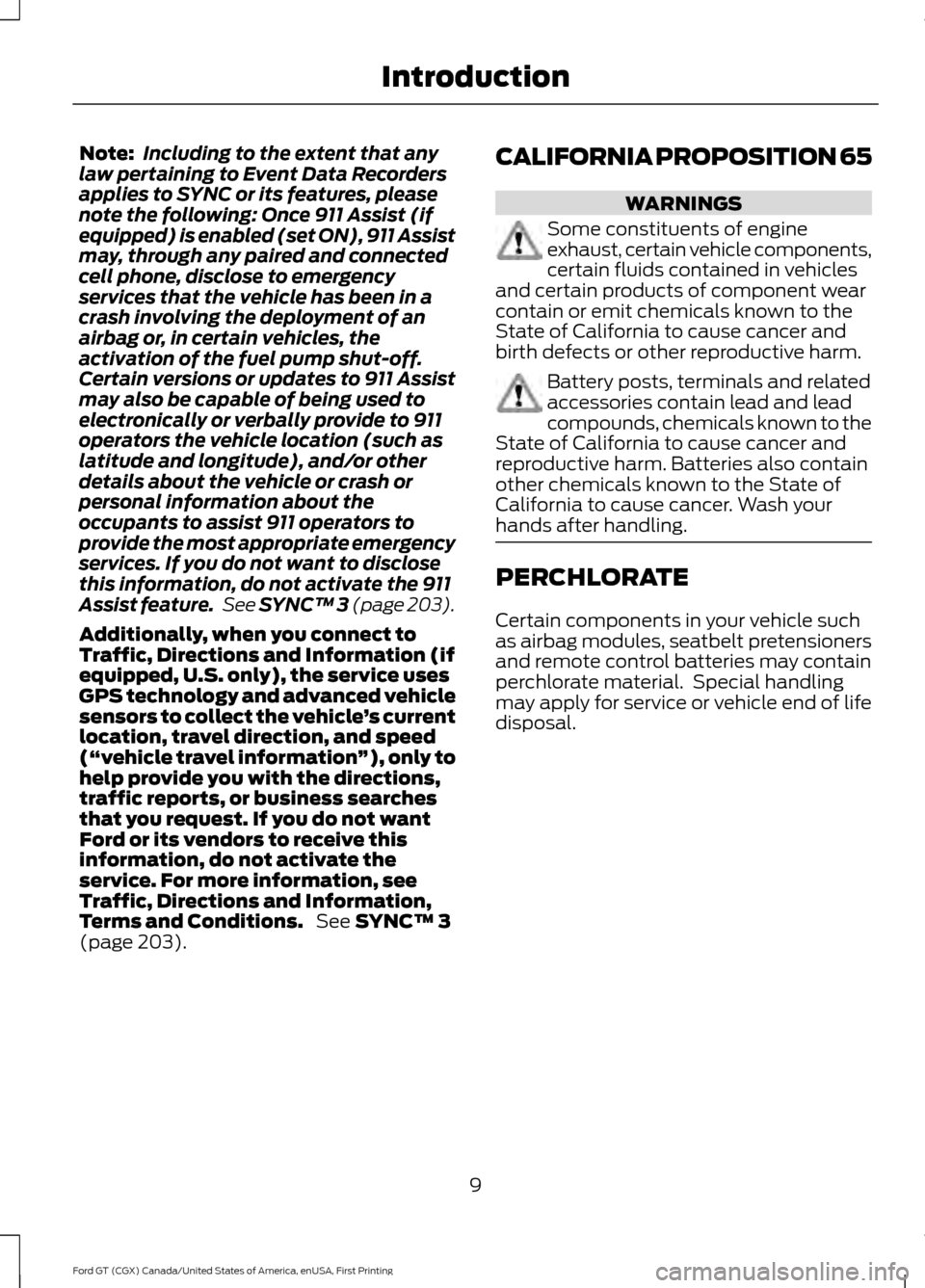
Note:
Including to the extent that any
law pertaining to Event Data Recorders
applies to SYNC or its features, please
note the following: Once 911 Assist (if
equipped) is enabled (set ON), 911 Assist
may, through any paired and connected
cell phone, disclose to emergency
services that the vehicle has been in a
crash involving the deployment of an
airbag or, in certain vehicles, the
activation of the fuel pump shut-off.
Certain versions or updates to 911 Assist
may also be capable of being used to
electronically or verbally provide to 911
operators the vehicle location (such as
latitude and longitude), and/or other
details about the vehicle or crash or
personal information about the
occupants to assist 911 operators to
provide the most appropriate emergency
services. If you do not want to disclose
this information, do not activate the 911
Assist feature. See SYNC™ 3 (page 203).
Additionally, when you connect to
Traffic, Directions and Information (if
equipped, U.S. only), the service uses
GPS technology and advanced vehicle
sensors to collect the vehicle ’s current
location, travel direction, and speed
(“ vehicle travel information ”), only to
help provide you with the directions,
traffic reports, or business searches
that you request. If you do not want
Ford or its vendors to receive this
information, do not activate the
service. For more information, see
Traffic, Directions and Information,
Terms and Conditions. See
SYNC™ 3
(page 203). CALIFORNIA PROPOSITION 65 WARNINGS
Some constituents of engine
exhaust, certain vehicle components,
certain fluids contained in vehicles
and certain products of component wear
contain or emit chemicals known to the
State of California to cause cancer and
birth defects or other reproductive harm. Battery posts, terminals and related
accessories contain lead and lead
compounds, chemicals known to the
State of California to cause cancer and
reproductive harm. Batteries also contain
other chemicals known to the State of
California to cause cancer. Wash your
hands after handling. PERCHLORATE
Certain components in your vehicle such
as airbag modules, seatbelt pretensioners
and remote control batteries may contain
perchlorate material. Special handling
may apply for service or vehicle end of life
disposal.
9
Ford GT (CGX) Canada/United States of America, enUSA, First Printing Introduction
Page 29 of 313
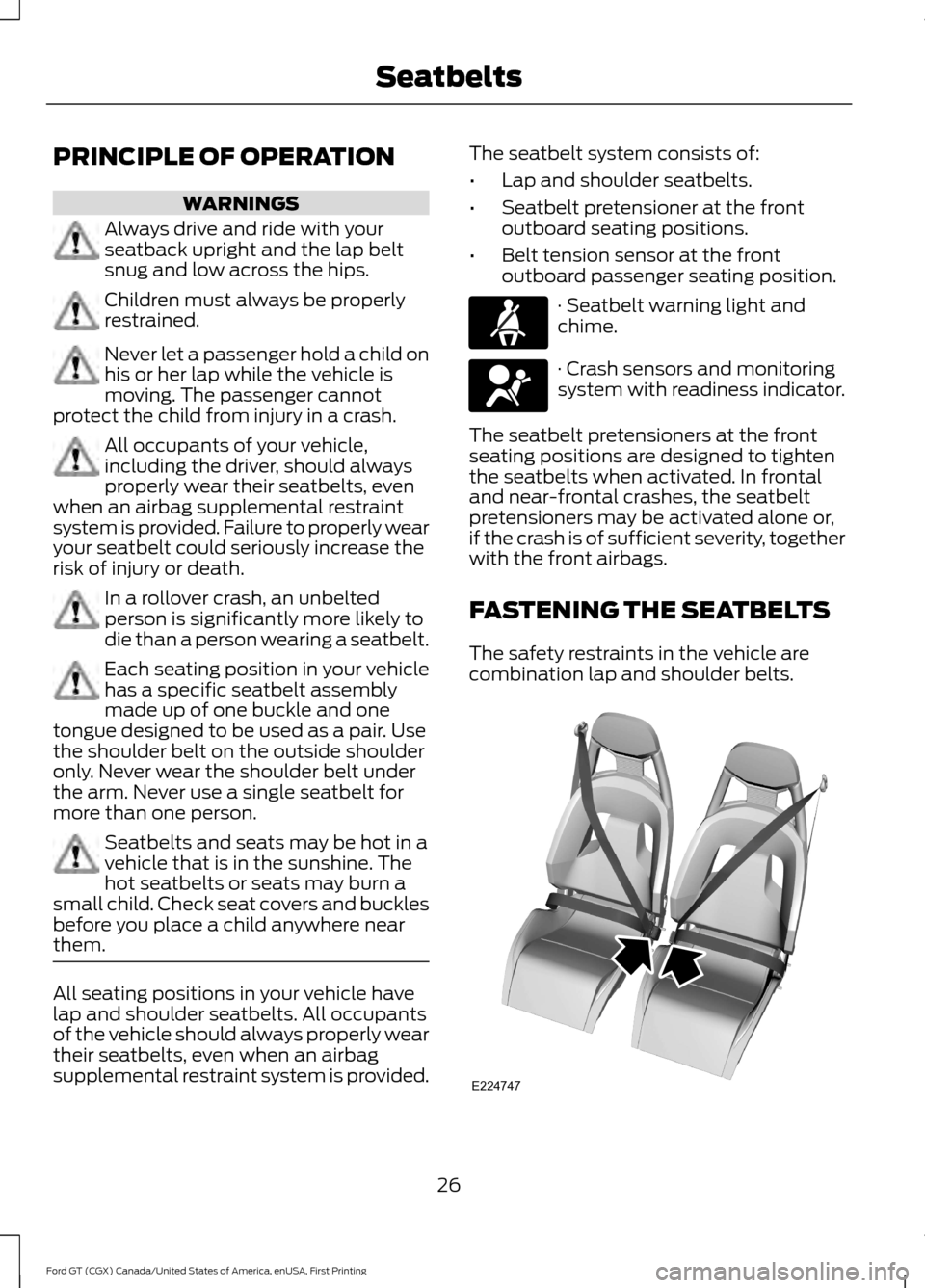
PRINCIPLE OF OPERATION
WARNINGS
Always drive and ride with your
seatback upright and the lap belt
snug and low across the hips.
Children must always be properly
restrained.
Never let a passenger hold a child on
his or her lap while the vehicle is
moving. The passenger cannot
protect the child from injury in a crash. All occupants of your vehicle,
including the driver, should always
properly wear their seatbelts, even
when an airbag supplemental restraint
system is provided. Failure to properly wear
your seatbelt could seriously increase the
risk of injury or death. In a rollover crash, an unbelted
person is significantly more likely to
die than a person wearing a seatbelt.
Each seating position in your vehicle
has a specific seatbelt assembly
made up of one buckle and one
tongue designed to be used as a pair. Use
the shoulder belt on the outside shoulder
only. Never wear the shoulder belt under
the arm. Never use a single seatbelt for
more than one person. Seatbelts and seats may be hot in a
vehicle that is in the sunshine. The
hot seatbelts or seats may burn a
small child. Check seat covers and buckles
before you place a child anywhere near
them. All seating positions in your vehicle have
lap and shoulder seatbelts. All occupants
of the vehicle should always properly wear
their seatbelts, even when an airbag
supplemental restraint system is provided. The seatbelt system consists of:
•
Lap and shoulder seatbelts.
• Seatbelt pretensioner at the front
outboard seating positions.
• Belt tension sensor at the front
outboard passenger seating position. · Seatbelt warning light and
chime.
· Crash sensors and monitoring
system with readiness indicator.
The seatbelt pretensioners at the front
seating positions are designed to tighten
the seatbelts when activated. In frontal
and near-frontal crashes, the seatbelt
pretensioners may be activated alone or,
if the crash is of sufficient severity, together
with the front airbags.
FASTENING THE SEATBELTS
The safety restraints in the vehicle are
combination lap and shoulder belts. 26
Ford GT (CGX) Canada/United States of America, enUSA, First Printing SeatbeltsE71880 E67017 E224747
Page 35 of 313
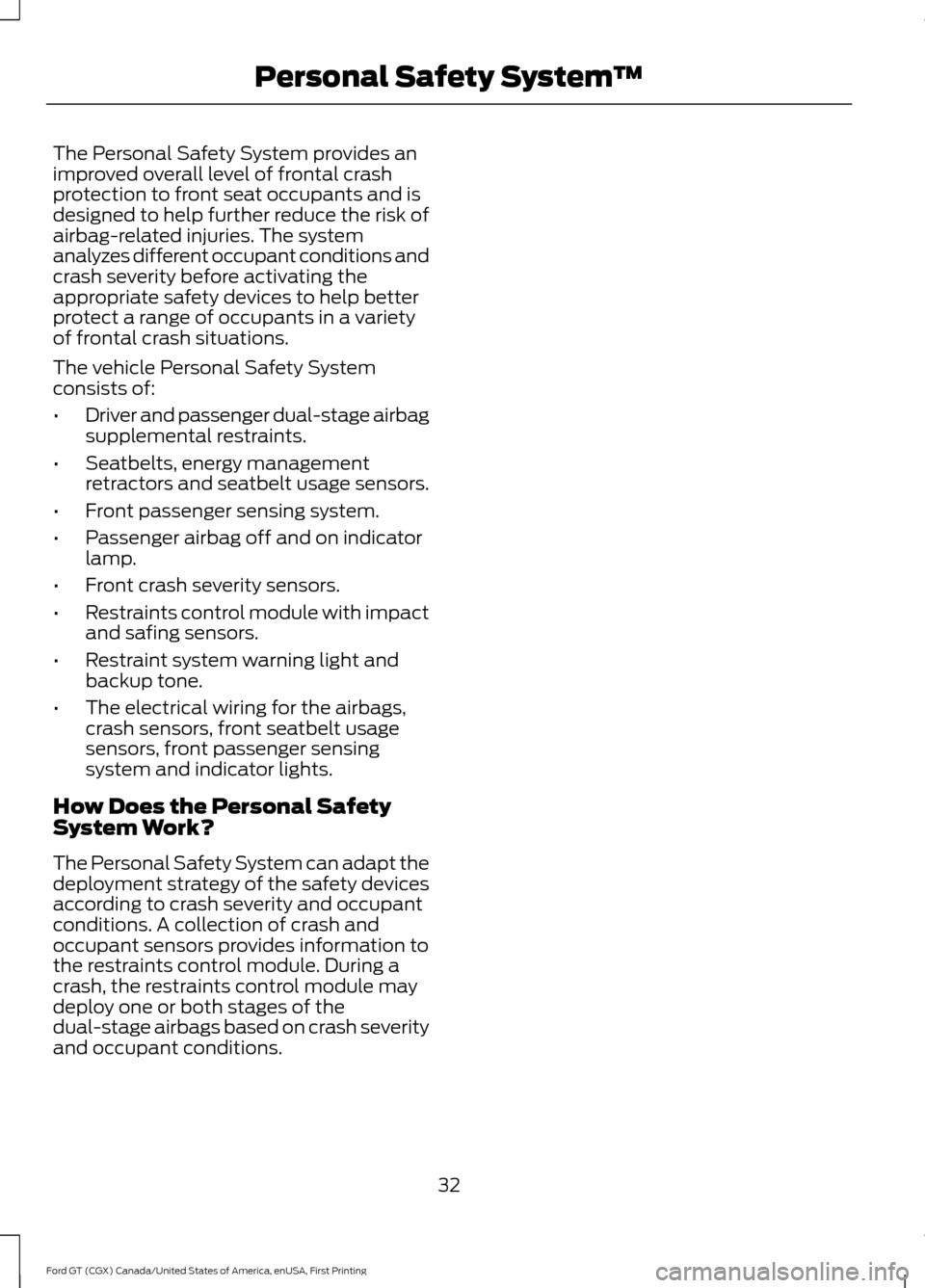
The Personal Safety System provides an
improved overall level of frontal crash
protection to front seat occupants and is
designed to help further reduce the risk of
airbag-related injuries. The system
analyzes different occupant conditions and
crash severity before activating the
appropriate safety devices to help better
protect a range of occupants in a variety
of frontal crash situations.
The vehicle Personal Safety System
consists of:
•
Driver and passenger dual-stage airbag
supplemental restraints.
• Seatbelts, energy management
retractors and seatbelt usage sensors.
• Front passenger sensing system.
• Passenger airbag off and on indicator
lamp.
• Front crash severity sensors.
• Restraints control module with impact
and safing sensors.
• Restraint system warning light and
backup tone.
• The electrical wiring for the airbags,
crash sensors, front seatbelt usage
sensors, front passenger sensing
system and indicator lights.
How Does the Personal Safety
System Work?
The Personal Safety System can adapt the
deployment strategy of the safety devices
according to crash severity and occupant
conditions. A collection of crash and
occupant sensors provides information to
the restraints control module. During a
crash, the restraints control module may
deploy one or both stages of the
dual-stage airbags based on crash severity
and occupant conditions.
32
Ford GT (CGX) Canada/United States of America, enUSA, First Printing Personal Safety System
™
Page 37 of 313
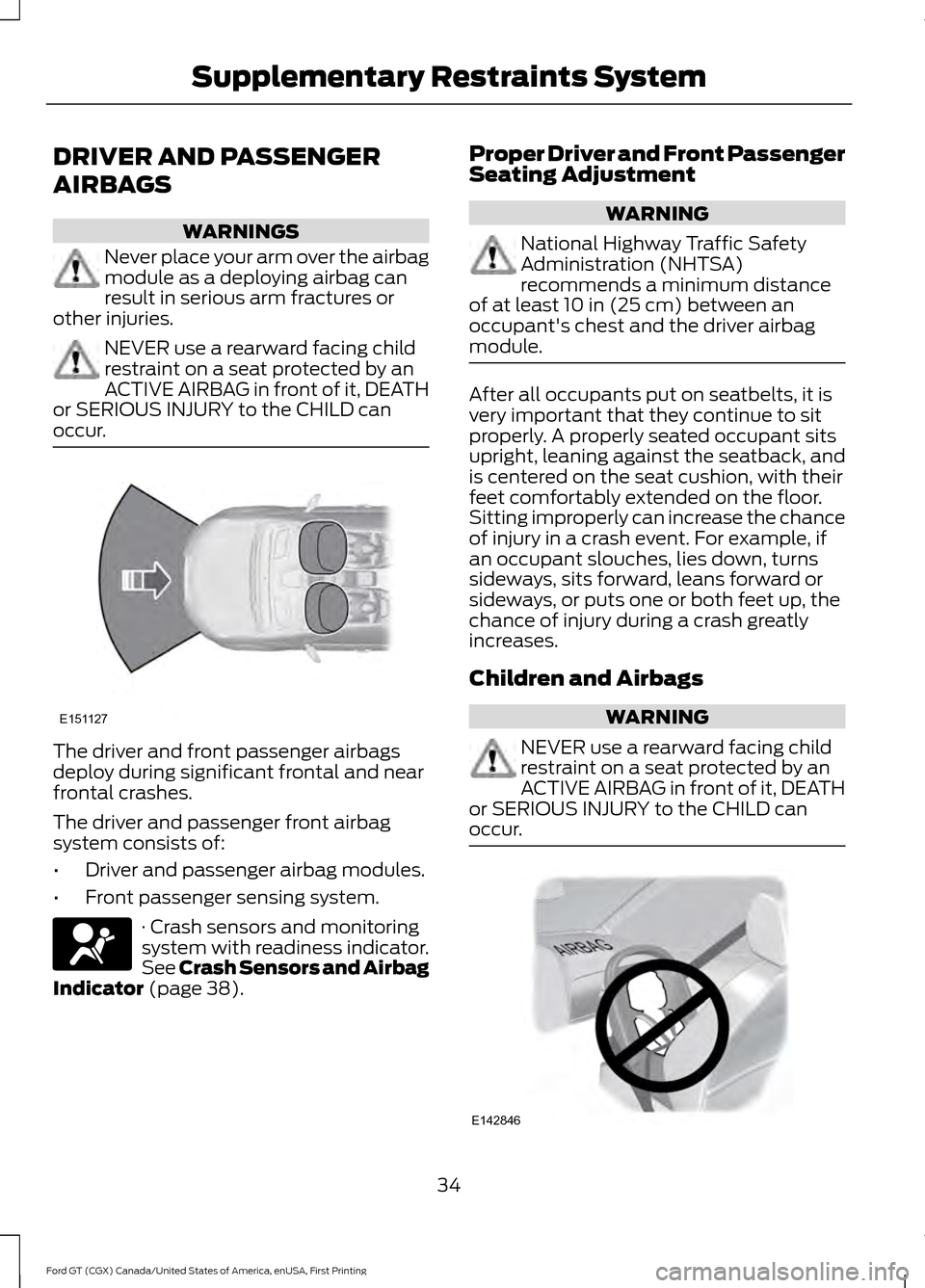
DRIVER AND PASSENGER
AIRBAGS
WARNINGS
Never place your arm over the airbag
module as a deploying airbag can
result in serious arm fractures or
other injuries. NEVER use a rearward facing child
restraint on a seat protected by an
ACTIVE AIRBAG in front of it, DEATH
or SERIOUS INJURY to the CHILD can
occur. The driver and front passenger airbags
deploy during significant frontal and near
frontal crashes.
The driver and passenger front airbag
system consists of:
•
Driver and passenger airbag modules.
• Front passenger sensing system. · Crash sensors and monitoring
system with readiness indicator.
See Crash Sensors and Airbag
Indicator (page 38). Proper Driver and Front Passenger
Seating Adjustment WARNING
National Highway Traffic Safety
Administration (NHTSA)
recommends a minimum distance
of at least
10 in (25 cm) between an
occupant's chest and the driver airbag
module. After all occupants put on seatbelts, it is
very important that they continue to sit
properly. A properly seated occupant sits
upright, leaning against the seatback, and
is centered on the seat cushion, with their
feet comfortably extended on the floor.
Sitting improperly can increase the chance
of injury in a crash event. For example, if
an occupant slouches, lies down, turns
sideways, sits forward, leans forward or
sideways, or puts one or both feet up, the
chance of injury during a crash greatly
increases.
Children and Airbags
WARNING
NEVER use a rearward facing child
restraint on a seat protected by an
ACTIVE AIRBAG in front of it, DEATH
or SERIOUS INJURY to the CHILD can
occur. 34
Ford GT (CGX) Canada/United States of America, enUSA, First Printing Supplementary Restraints SystemE151127 E67017 E142846
Page 38 of 313
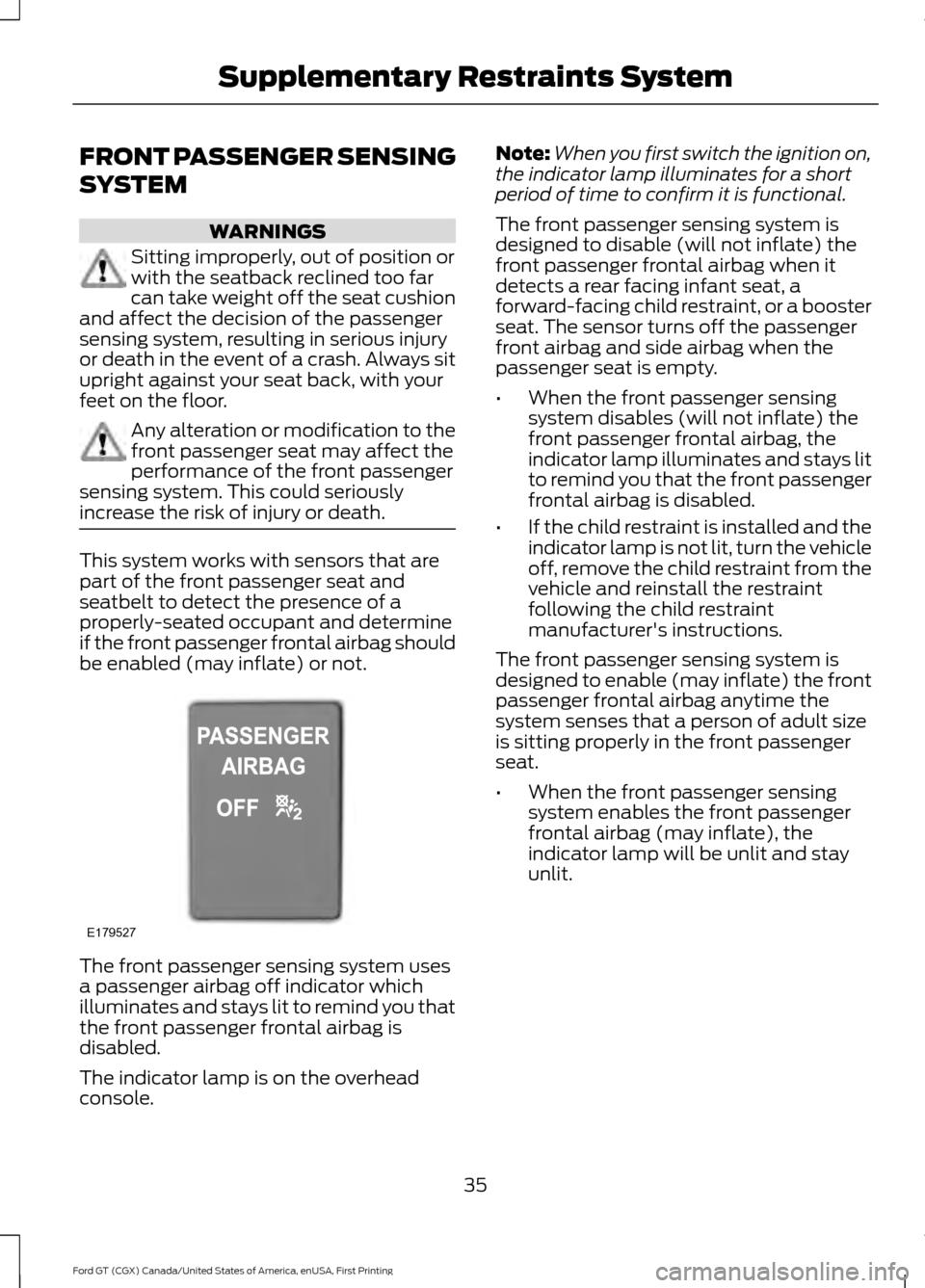
FRONT PASSENGER SENSING
SYSTEM
WARNINGS
Sitting improperly, out of position or
with the seatback reclined too far
can take weight off the seat cushion
and affect the decision of the passenger
sensing system, resulting in serious injury
or death in the event of a crash. Always sit
upright against your seat back, with your
feet on the floor. Any alteration or modification to the
front passenger seat may affect the
performance of the front passenger
sensing system. This could seriously
increase the risk of injury or death. This system works with sensors that are
part of the front passenger seat and
seatbelt to detect the presence of a
properly-seated occupant and determine
if the front passenger frontal airbag should
be enabled (may inflate) or not.
The front passenger sensing system uses
a passenger airbag off indicator which
illuminates and stays lit to remind you that
the front passenger frontal airbag is
disabled.
The indicator lamp is on the overhead
console. Note:
When you first switch the ignition on,
the indicator lamp illuminates for a short
period of time to confirm it is functional.
The front passenger sensing system is
designed to disable (will not inflate) the
front passenger frontal airbag when it
detects a rear facing infant seat, a
forward-facing child restraint, or a booster
seat. The sensor turns off the passenger
front airbag and side airbag when the
passenger seat is empty.
• When the front passenger sensing
system disables (will not inflate) the
front passenger frontal airbag, the
indicator lamp illuminates and stays lit
to remind you that the front passenger
frontal airbag is disabled.
• If the child restraint is installed and the
indicator lamp is not lit, turn the vehicle
off, remove the child restraint from the
vehicle and reinstall the restraint
following the child restraint
manufacturer's instructions.
The front passenger sensing system is
designed to enable (may inflate) the front
passenger frontal airbag anytime the
system senses that a person of adult size
is sitting properly in the front passenger
seat.
• When the front passenger sensing
system enables the front passenger
frontal airbag (may inflate), the
indicator lamp will be unlit and stay
unlit.
35
Ford GT (CGX) Canada/United States of America, enUSA, First Printing Supplementary Restraints SystemE179527
Page 39 of 313
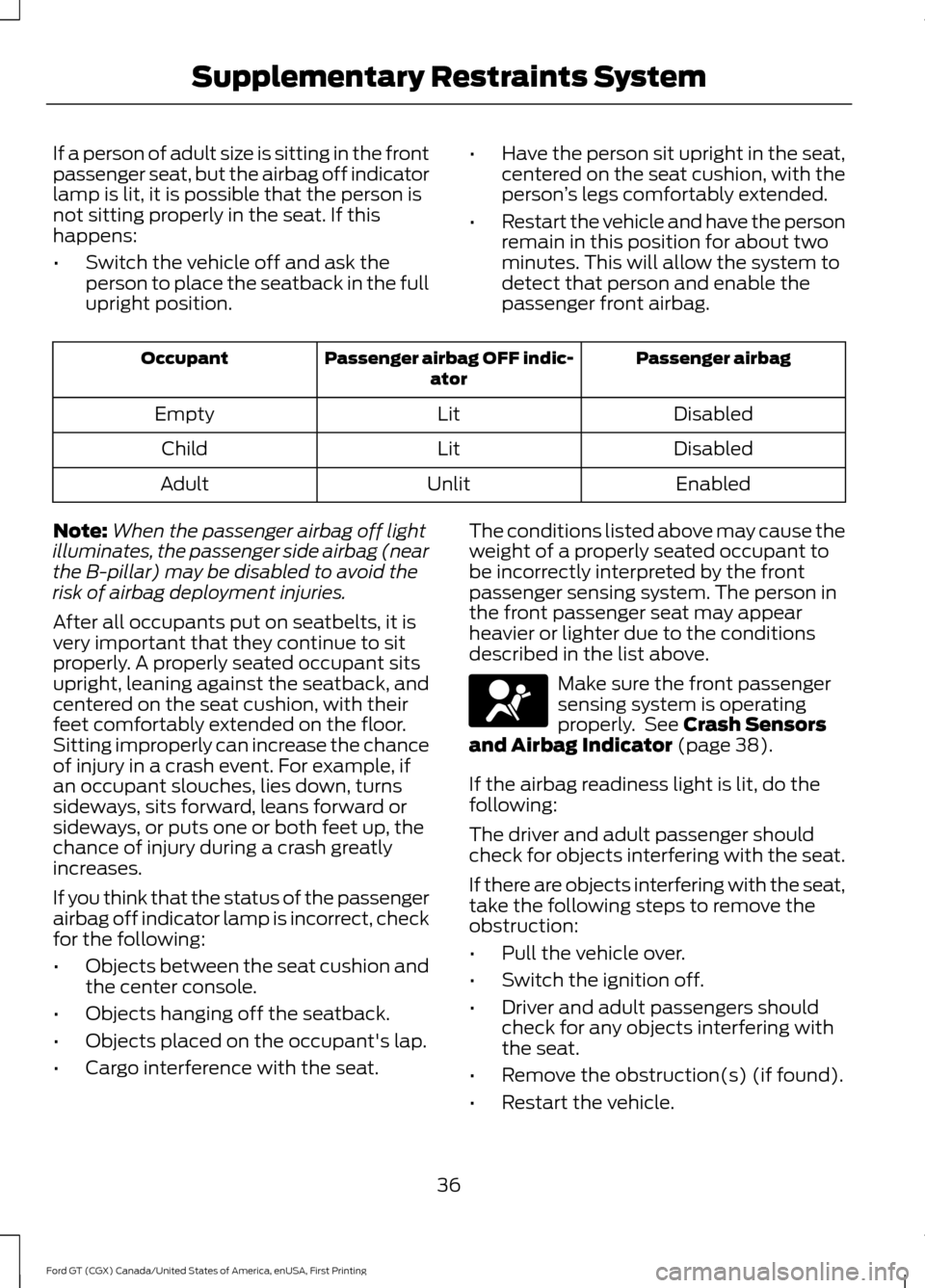
If a person of adult size is sitting in the front
passenger seat, but the airbag off indicator
lamp is lit, it is possible that the person is
not sitting properly in the seat. If this
happens:
•
Switch the vehicle off and ask the
person to place the seatback in the full
upright position. •
Have the person sit upright in the seat,
centered on the seat cushion, with the
person ’s legs comfortably extended.
• Restart the vehicle and have the person
remain in this position for about two
minutes. This will allow the system to
detect that person and enable the
passenger front airbag. Passenger airbag
Passenger airbag OFF indic-
ator
Occupant
Disabled
Lit
Empty
Disabled
Lit
Child
Enabled
Unlit
Adult
Note: When the passenger airbag off light
illuminates, the passenger side airbag (near
the B-pillar) may be disabled to avoid the
risk of airbag deployment injuries.
After all occupants put on seatbelts, it is
very important that they continue to sit
properly. A properly seated occupant sits
upright, leaning against the seatback, and
centered on the seat cushion, with their
feet comfortably extended on the floor.
Sitting improperly can increase the chance
of injury in a crash event. For example, if
an occupant slouches, lies down, turns
sideways, sits forward, leans forward or
sideways, or puts one or both feet up, the
chance of injury during a crash greatly
increases.
If you think that the status of the passenger
airbag off indicator lamp is incorrect, check
for the following:
• Objects between the seat cushion and
the center console.
• Objects hanging off the seatback.
• Objects placed on the occupant's lap.
• Cargo interference with the seat. The conditions listed above may cause the
weight of a properly seated occupant to
be incorrectly interpreted by the front
passenger sensing system. The person in
the front passenger seat may appear
heavier or lighter due to the conditions
described in the list above. Make sure the front passenger
sensing system is operating
properly. See Crash Sensors
and Airbag Indicator (page 38).
If the airbag readiness light is lit, do the
following:
The driver and adult passenger should
check for objects interfering with the seat.
If there are objects interfering with the seat,
take the following steps to remove the
obstruction:
• Pull the vehicle over.
• Switch the ignition off.
• Driver and adult passengers should
check for any objects interfering with
the seat.
• Remove the obstruction(s) (if found).
• Restart the vehicle.
36
Ford GT (CGX) Canada/United States of America, enUSA, First Printing Supplementary Restraints SystemE67017
Page 40 of 313
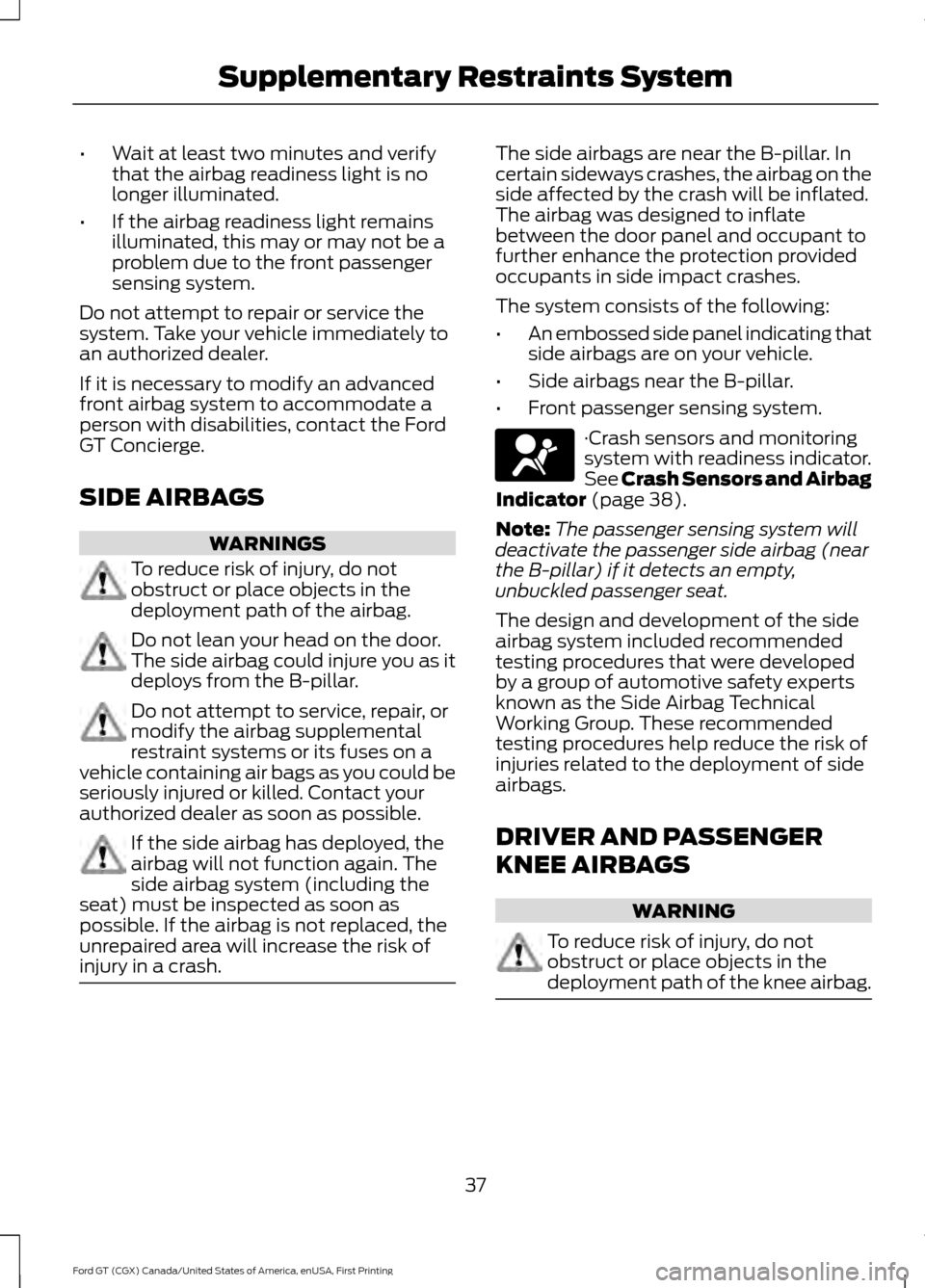
•
Wait at least two minutes and verify
that the airbag readiness light is no
longer illuminated.
• If the airbag readiness light remains
illuminated, this may or may not be a
problem due to the front passenger
sensing system.
Do not attempt to repair or service the
system. Take your vehicle immediately to
an authorized dealer.
If it is necessary to modify an advanced
front airbag system to accommodate a
person with disabilities, contact the Ford
GT Concierge.
SIDE AIRBAGS WARNINGS
To reduce risk of injury, do not
obstruct or place objects in the
deployment path of the airbag.
Do not lean your head on the door.
The side airbag could injure you as it
deploys from the B-pillar.
Do not attempt to service, repair, or
modify the airbag supplemental
restraint systems or its fuses on a
vehicle containing air bags as you could be
seriously injured or killed. Contact your
authorized dealer as soon as possible. If the side airbag has deployed, the
airbag will not function again. The
side airbag system (including the
seat) must be inspected as soon as
possible. If the airbag is not replaced, the
unrepaired area will increase the risk of
injury in a crash. The side airbags are near the B-pillar. In
certain sideways crashes, the airbag on the
side affected by the crash will be inflated.
The airbag was designed to inflate
between the door panel and occupant to
further enhance the protection provided
occupants in side impact crashes.
The system consists of the following:
•
An embossed side panel indicating that
side airbags are on your vehicle.
• Side airbags near the B-pillar.
• Front passenger sensing system. ·Crash sensors and monitoring
system with readiness indicator.
See Crash Sensors and Airbag
Indicator (page 38).
Note: The passenger sensing system will
deactivate the passenger side airbag (near
the B-pillar) if it detects an empty,
unbuckled passenger seat.
The design and development of the side
airbag system included recommended
testing procedures that were developed
by a group of automotive safety experts
known as the Side Airbag Technical
Working Group. These recommended
testing procedures help reduce the risk of
injuries related to the deployment of side
airbags.
DRIVER AND PASSENGER
KNEE AIRBAGS WARNING
To reduce risk of injury, do not
obstruct or place objects in the
deployment path of the knee airbag.
37
Ford GT (CGX) Canada/United States of America, enUSA, First Printing Supplementary Restraints SystemE67017
Page 41 of 313
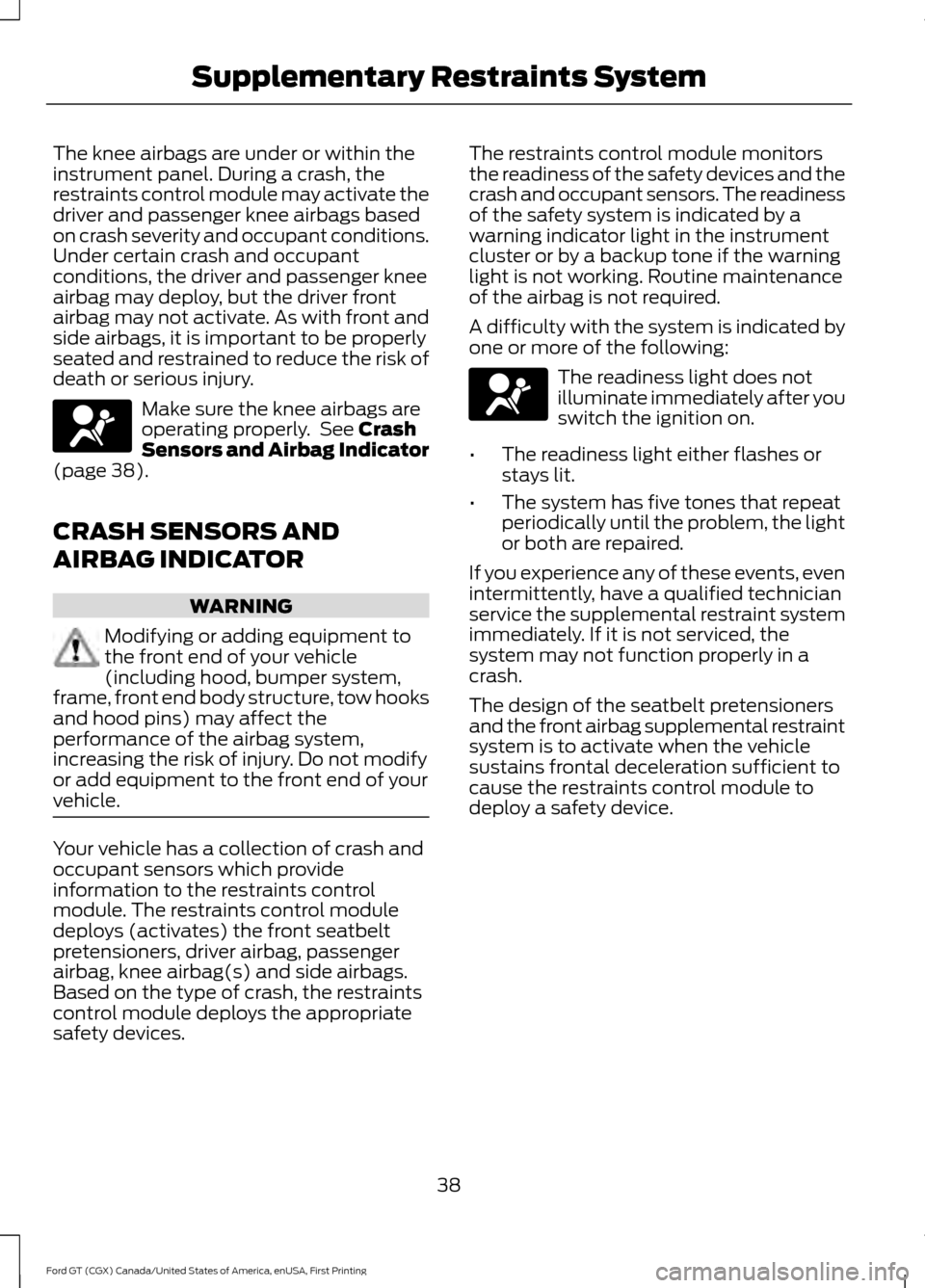
The knee airbags are under or within the
instrument panel. During a crash, the
restraints control module may activate the
driver and passenger knee airbags based
on crash severity and occupant conditions.
Under certain crash and occupant
conditions, the driver and passenger knee
airbag may deploy, but the driver front
airbag may not activate. As with front and
side airbags, it is important to be properly
seated and restrained to reduce the risk of
death or serious injury.
Make sure the knee airbags are
operating properly. See Crash
Sensors and Airbag Indicator
(page
38).
CRASH SENSORS AND
AIRBAG INDICATOR WARNING
Modifying or adding equipment to
the front end of your vehicle
(including hood, bumper system,
frame, front end body structure, tow hooks
and hood pins) may affect the
performance of the airbag system,
increasing the risk of injury. Do not modify
or add equipment to the front end of your
vehicle. Your vehicle has a collection of crash and
occupant sensors which provide
information to the restraints control
module. The restraints control module
deploys (activates) the front seatbelt
pretensioners, driver airbag, passenger
airbag, knee airbag(s) and side airbags.
Based on the type of crash, the restraints
control module deploys the appropriate
safety devices. The restraints control module monitors
the readiness of the safety devices and the
crash and occupant sensors. The readiness
of the safety system is indicated by a
warning indicator light in the instrument
cluster or by a backup tone if the warning
light is not working. Routine maintenance
of the airbag is not required.
A difficulty with the system is indicated by
one or more of the following:
The readiness light does not
illuminate immediately after you
switch the ignition on.
• The readiness light either flashes or
stays lit.
• The system has five tones that repeat
periodically until the problem, the light
or both are repaired.
If you experience any of these events, even
intermittently, have a qualified technician
service the supplemental restraint system
immediately. If it is not serviced, the
system may not function properly in a
crash.
The design of the seatbelt pretensioners
and the front airbag supplemental restraint
system is to activate when the vehicle
sustains frontal deceleration sufficient to
cause the restraints control module to
deploy a safety device.
38
Ford GT (CGX) Canada/United States of America, enUSA, First Printing Supplementary Restraints SystemE67017 E67017
Page 74 of 313
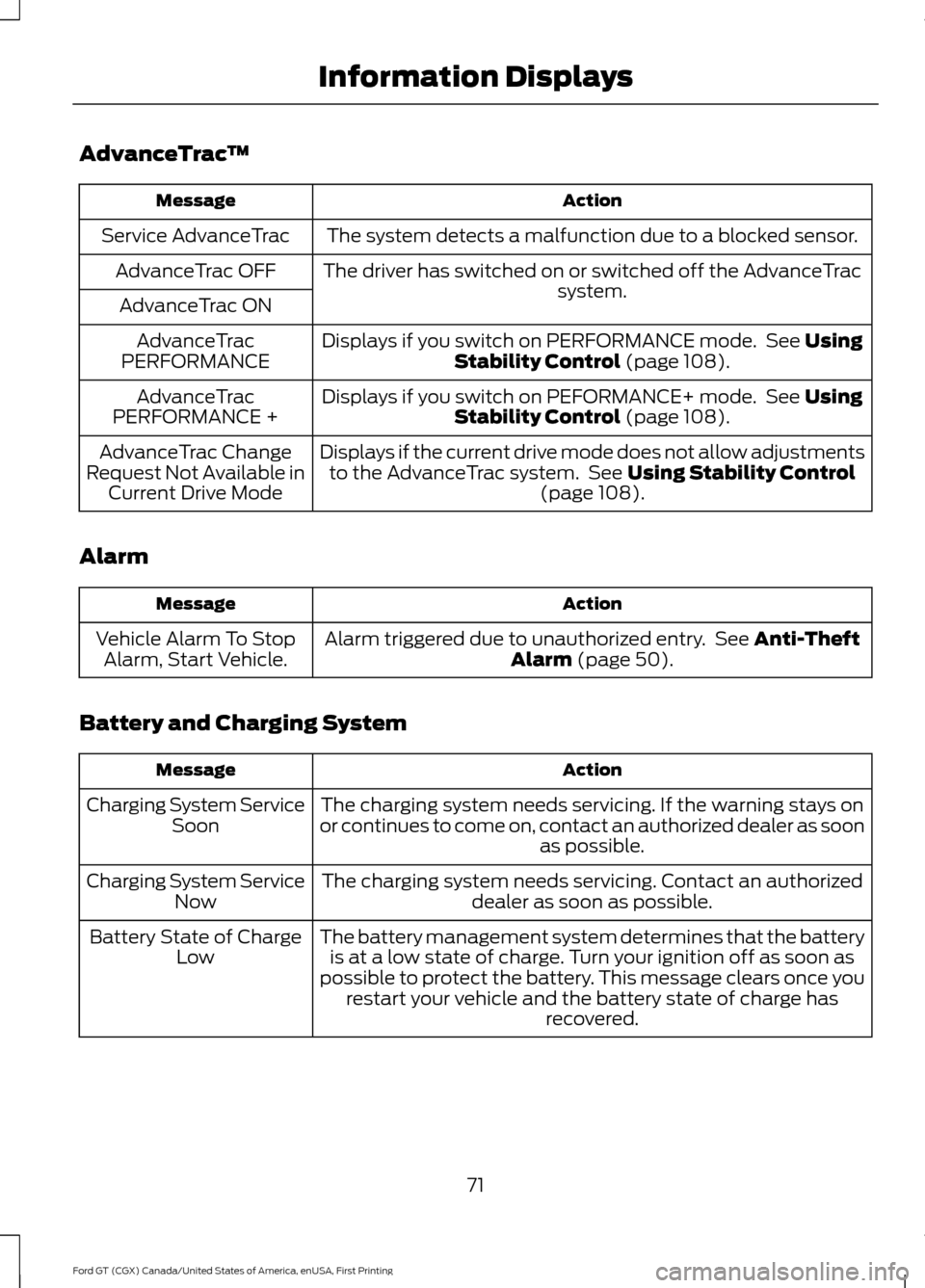
AdvanceTrac
™ Action
Message
The system detects a malfunction due to a blocked sensor.
Service AdvanceTrac
The driver has switched on or switched off the AdvanceTrac system.
AdvanceTrac OFF
AdvanceTrac ON Displays if you switch on PERFORMANCE mode. See Using
Stability Control (page 108).
AdvanceTrac
PERFORMANCE
Displays if you switch on PEFORMANCE+ mode. See
Using
Stability Control (page 108).
AdvanceTrac
PERFORMANCE +
Displays if the current drive mode does not allow adjustmentsto the AdvanceTrac system. See
Using Stability Control
(page 108).
AdvanceTrac Change
Request Not Available in Current Drive Mode
Alarm Action
Message
Alarm triggered due to unauthorized entry. See
Anti-Theft
Alarm (page 50).
Vehicle Alarm To Stop
Alarm, Start Vehicle.
Battery and Charging System Action
Message
The charging system needs servicing. If the warning stays on
or continues to come on, contact an authorized dealer as soon as possible.
Charging System Service
Soon
The charging system needs servicing. Contact an authorized dealer as soon as possible.
Charging System Service
Now
The battery management system determines that the batteryis at a low state of charge. Turn your ignition off as soon as
possible to protect the battery. This message clears once you restart your vehicle and the battery state of charge has recovered.
Battery State of Charge
Low
71
Ford GT (CGX) Canada/United States of America, enUSA, First Printing Information Displays